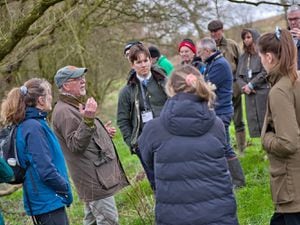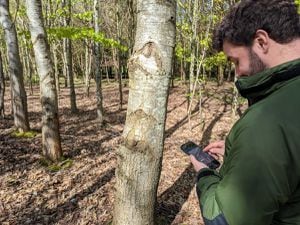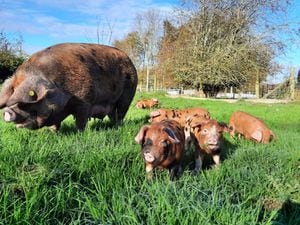Horrors of war recalled as brave Normandy veteran from Shropshire finally falls
Toby Neal recalls meeting war hero Harry Langford, one of the last surviving members of the King's Shropshire Light Infantry to fight in Normandy, who has died at the age of 97.
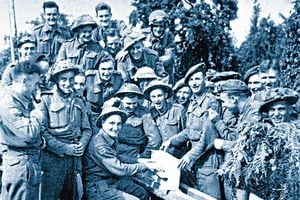
Amid the roar of the cannon, the stutter of the machine guns, and the serious risk of sudden and violent death, a bizarre little scene was played out.
In a field behind the church in the French village of Baron-sur-Odon, Shropshire soldier Harry Langford was dug in along with some of his colleagues from the 4th Battalion the King's Shropshire Light Infantry.
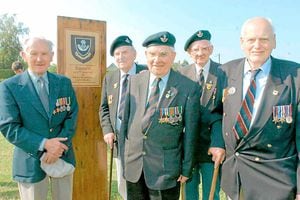
They were not the only occupants in the field. There was also a cow and a tethered donkey.
Standing next to the very spot almost exactly 60 years later, Mr Langford recalled that from time to time the cow needed milking, so one of the soldiers, known as 'Butch', who had been a farm boy, would get out of his trench every so often during the fighting to milk the cow.
The battalion was pinned down in the village for weeks. The donkey was still there, unscathed, when the Shropshire soldiers moved out.
Mr Langford, of Mytton Oak Road, Shrewsbury, was among a small band of veterans on that 60th anniversary visit in May 2004 who had survived the maelstrom of war when many of their colleagues were never to return home.
However, no old soldier can survive the march of time and now Mr Langford, one of the last of the wartime battalion which fought through the Normandy campaign and during the advance into Germany and later helped capture some of the Nazi high command, has died at the age of 97.
His funeral was on March 6.
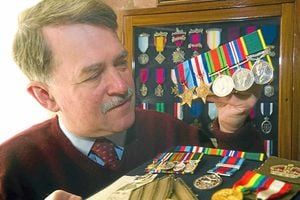
Medals and documents belonging to Mr Langford, who was a platoon sergeant, have now been donated to the Shropshire Regimental Museum in Shrewsbury by his daughter, Suzanne.
Peter Duckers, curator of the museum, said the archive of documents would be put on display as soon as possible.
Among the items in the collection are Mr Langford's campaign medals for serving in Northern Europe and a Territorial Army long service medal.
Mr Duckers said: "Harry was a very well-known figure and he had been on a number of battlefield tours detailing the story of what they did.
"After he died, the family got in contact with us and said Harry had wanted the medals to come to us. They will be going out on display as soon as possible."
He said the battalion, made up of local volunteers from Shropshire, had endured a 'remarkable' war after landing at Normandy on June 14, 1944, just a week after the initial D-Day landings on June 6.

Baron-sur-Odon, not far from Caen, has a special place in the history of the 4th KSLI as it was the place the Shropshires were first blooded in battle, coming under attack by fanatical SS men.
"Believe me, it was a terrible baptism of fire," said Mr Langford during the 2004 visit, during which the veterans were honoured guests at a ceremony in which the village square was renamed after the battalion in gratitude for the Shropshires' liberation of the village.
The Shropshire regiment soldiers had moved into Baron, then a village of just 200 people, in the late evening of June 27, 1944.
Its significance was that it lay on a river and on the lower slope of a broad low hill, a feature which in the haze and mist of that 2004 visit looked like unremarkable agricultural land, but in the bitter fighting in the weeks following D-Day offered members of the SS Panzer Division, which occupied the higher ground, uninterrupted views of a large swathe of the Normandy battlefield around Caen.
Years later, Mr Langford described his experiences at Baron-sur-Odon to Graham Shepherd of Age Concern Shropshire.
"As we approached we began to see casualties coming back in jeeps – blood everywhere.
"There were British and German bodies, and burned out tanks and Bren carriers at the side of the road. It brought us down to earth.
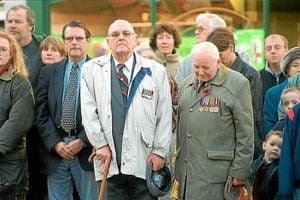
"We dug in at Baron and the German counter-attacked us very hard. Our artillery did a very good job of breaking up the attacks.
"After one there were many German bodies in front of the position. The Germans shelled us constantly. It was very draining. On the second day we lost our first man, killed in the mortar platoon. It was Freddie Heath.
"We stood to at dawn and he was hit by shrapnel from an air burst (a shell timed to explode above the ground).
"He was still alive when they got him to the regimental aid post, but he died before he got back to Britain. He's buried at Bayeux War Cemetery .
"It was a shock. Freddie was a Shrewsbury lad and I'd known him since before we joined up .
"You can't believe somebody you knew so well could be killed like that, but there was so much going on around us you had to put it to one side.
"One of my great friends was Cooky (Ron Cookson), a stretcher bearer, who only died in 2002.
The stretcher bearers were so brave. They would tend the wounded while under fire and were open to anything the Germans could throw at them.
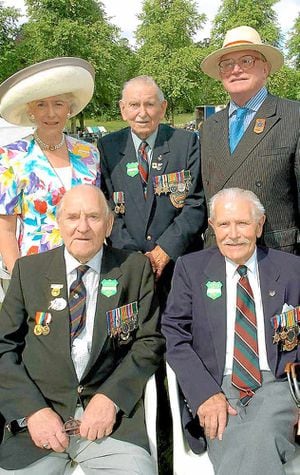
"The early casualties made the men of the KSLI acutely aware that the war was not going to be a walkover.
"Facing them were the men of three SS divisions, and their position was at the head of a corridor over the river Odon stretching into enemy-held territory.
"Ahead of us was a cornfield through which the Germans mounted many counter attacks, while the positions in Baron were shelled and mortared constantly.
"Any movement during the day would attract a barrage of shell fire.
"On June 30 the SS attacked at night and nearly succeeded in dislodging the men of the KSLI . The following morning the bodies of 25 Germans were found within our perimeter, and 10 prisoners were taken. Some of the Germans, from the SS Hitler Youth Division , were just 16 year-old boys.
"Baron was also the first place the 4th KSLI experienced the Nebelwerfer rocket launcher.
"This six-barrelled rocket artillery had a terrifying effect on those on the receiving end of it, thanks to the screaming noise they made in flight.
"Allied soldiers christened them 'Moaning Minnies'. We first heard them as we drove into Baron in our carriers.
"The noise was terrifying – it felt like they were aiming at you . Then there were six explosions all around . But once you got used to the noise they weren't so bad.
"We held Baron until we were relieved on 4/5th July , holding the line on a battlefield that seemed more akin to the horrors of the First World War trenches than the mobile battlefields of World War Two. In that time the battalion lost 23 men killed and 77 wounded – a quarter of their fighting strength."
In total the battalion, which would have been about 700 men, suffered 114 dead or wounded in the Baron fighting.
After fighting their way up through France, the battalion ended the war in April 1945 at the Danish border.
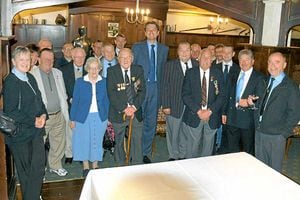
They were one of the battalions which, under Brigadier Jack Churcher, occupied Flensburg, the seat of the remnant Nazi government under Grand Admiral Karl Doenitz. The arrest of Doenitz and his associates was effected by 4KSLI and the Herefords at the very end of the battalion's war service.
The battalion was the first Allied unit to enter Antwerp in September 1944.
They were also among the first Allied forces to discover the horrors of the Belsen concentration camp, where tens of thousands of ill and emaciated prisoners, including Anne Frank, were in desperate need of medical attention.
Many years later, Mr Langford told how the 4KSLI had found the camp on 15th April, 1945 while heading for Bergen.
He recalled: "No one quite knew what was happening ahead, but eventually word came down that negotiations were going on between the Germans and 11th Armoured Division , of which we were part, not to fight in the area .
"It seemed that there was an outbreak of typhus in a camp in the area which was reported to be holding political prisoners.
"The road we were on ran past the camp, which we later found out to be the concentration camp at Belsen.
"The camp was said to hold some 60,000 political prisoners , who were the victims of the typhus epidemic so virulent that their captors dare not let them loose.
"Word was passed down that no one was to approach the fence of the camp, or to leave their vehicles. It seemed the whole medical team of the division was rushed to the spot and immediately took control.
"I was in my carrier half way up the column, and I spent about an hour outside the fence of the camp, and could see scores of inmates dying in front of our eyes."
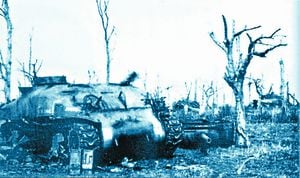
Peter Duckers, of the Shropshire Regimental Museum, said: "For Territorial soldiers, who were originally part-time, the war they had was quite remarkable in terms of the active service and historical significance."
Mr Langford, who in civilian life served as president of Shrewsbury Conservative Club, made several trips to Normandy in later life to help with battlefield tours organised by the KSLI's successors the Light Infantry.
Major Nigel Jones, regional secretary for The Rifles, which is a direct descendant of the KSLI, said Mr Langford's recollections on the tours had made a great impression on everyone who heard him speak.
"He was able to describe the circumstances and the battles that took place and he brought the tales to life," he said.
"He had a wonderful memory for the battles and was excellent company. He was really, really proud to have served his country with the county regiment."
Major Jones said that instead of birthday presents, Mr Langford used to ask his friends and family to make donations to the Shropshire Regimental Museum.
Those donations had raised thousands over the years – a fitting tribute to a man who went to hell and back.
Related content:
Kings Shropshire Light Infantry Normandy hero Harry Langford dies at 97
Star comment: Harry Langford's death is big loss to proud nation

